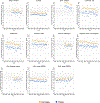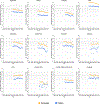Gallbladder and extrahepatic bile duct cancers in the Americas: Incidence and mortality patterns and trends
- PMID: 31922259
- PMCID: PMC8629410
- DOI: 10.1002/ijc.32863
Gallbladder and extrahepatic bile duct cancers in the Americas: Incidence and mortality patterns and trends
Abstract
Trends in gallbladder cancer incidence and mortality in populations across the Americas can provide insight into shifting epidemiologic patterns and the current and potential impact of preventative and curative programs. Estimates of gallbladder and extrahepatic bile duct cancer incidence and mortality for the year 2018 were extracted from International Agency for Research on Cancer (IARC) GLOBOCAN database for 185 countries. Recorded registry-based incidence from 13 countries was extracted from IARCs Cancer Incidence in Five Continents series and corresponding national deaths from the WHO mortality database. Among females, the highest estimated incidence for gallbladder and extrahepatic bile duct cancer in the Americas were found in Bolivia (21.0 per 100,000), Chile (11.7) and Peru (6.0). In the US, the highest incidence rates were observed among Hispanics (1.8). In the Chilean population, gallbladder cancer rates declined in both females and males between 1998 and 2012. Rates dropped slightly in Canada, Costa Rica, US Whites and Hispanics in Los Angeles. Gallbladder cancer mortality rates also decreased across the studied countries, although rising trends were observed in Colombia and Canada after 2010. Countries within Southern and Central America tended to have a higher proportion of unspecified biliary tract cancers. In public health terms, the decline in gallbladder cancer incidence and mortality rates is encouraging. However, the slight increase in mortality rates during recent years in Colombia and Canada warrant further attention. Higher proportions of unspecified biliary tract cancers (with correspondingly higher mortality rates) suggest more rigorous pathology procedures may be needed after surgery.
Keywords: ampulla of Vater; carcinomas of gallbladder; extrahepatic and biliary duct cancers; incidence; mortality.
© 2020 UICC.
Conflict of interest statement
Conflict of interest
None
Figures





References
-
- Ferlay J, Ervik M, Lam F, Colombet M, Mery L, Piñeros M, Znaor A, Soerjomataram I, Bray F (2018). Global Cancer Observatory: Cancer Today. Lyon, France: International Agency for Research on Cancer. [Internet]. Available from: https://gco.iarc.fr/today
-
- Randi G, Franceschi S, La Vecchia C. Gallbladder cancer worldwide: Geographical distribution and risk factors. Int J Cancer. 2006. April 1;118(7):1591–602. - PubMed
-
- Lorenzo Bermejo J, Boekstegers F, González Silos R, Marcelain K, Baez Benavides P, Barahona Ponce C, et al. Subtypes of Native American ancestry and leading causes of death: Mapuche ancestry-specific associations with gallbladder cancer risk in Chile. Tishkoff SA, editor. PLOS Genet. 2017. May 25;13(5):e1006756. - PMC - PubMed
-
- Bosman FT, World Health Organization, International Agency for Research on Cancer, editors. WHO classification of tumours of the digestive system. 4th ed. Lyon: International Agency for Research on Cancer; 2010. 417 p. (World Health Organization classification of tumours).
Publication types
MeSH terms
Grants and funding
LinkOut - more resources
Full Text Sources
Medical

